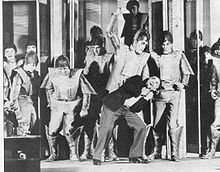この項目「
AIによる乗っ取り 」は翻訳されたばかりのものです。不自然あるいは曖昧な表現などが含まれる可能性があり、このままでは読みづらいかもしれません。(原文:
英語版 )
修正、加筆に協力し、現在の表現をより自然な表現にして下さる方を求めています。
ノートページ や
履歴 も参照してください。
(2023年4月 )
1920年の劇R.U.R. AIによる乗っ取り (エーアイによるのっとり)は、コンピュータプログラム またはロボット が、人類を放逐し、地球 を実効支配 することで、人工知能 (AI)が地球上の主要知能となるという仮想のシナリオである。起こりうるシナリオとしては、人間の仕事の完全なる置き換えや、超知能 による乗っ取り、ロボット反乱 という人気のある[要出典 発想などが含まれる。AIによる乗っ取りはサイエンス・フィクション で人気な題材である。スティーヴン・ホーキング やイーロン・マスク といった著名人が、将来の超知能機械を確実に人間の制御下に置けるようにするための、予防措置の研究をすることを主張している[要出典 。
経済学者 間での伝統的な合意事項は、技術の進歩は長期間の失業 を生み出さないということ[要出典 である。しかし、最近のロボティクス や人工知能分野でのイノベーション のために、人間の仕事が奪われ、様々な分野で生活費を稼ぐための仕事が無くなり、経済危機を引き起こすという懸念が高まっている[ 1] [ 2] [ 3] [ 4] [ 5]
AI技術はここ数年で広く採用されてきた。AI技術は、従来の労働者の多くにとって代わったが、新たな雇用機会を生み出してもいる。最もAI代替しやすい産業には、輸送業、小売業、軍事産業が含まれる。例えば、AI軍事技術により、兵士が怪我のリスクを冒さずに遠隔で作戦を遂行することができるようになる。作家のデイブ・ボンドは、AI技術が発展し拡大を続けるにつれて、人間とロボットの関係は変化することになり、技術は生活の幾つかの側面に密接に統合されることになると述べた。AIにより、特に反復作業が多い分野では代替される労働者もいるが、AIは他の部門で新しい機会も創造すると考えられる[ 6] [ 7]
コンピュータ統合生産は、コンピュータを生産過程を制御するために利用する。これによって、個々の過程はお互いに情報を交換して、行動を始めることができる。コンピュータの統合によって、製造でのミスを減らした上で高速化できる可能性もあるが、最大の利点は自動化された製造過程を生み出すことができることである。コンピュータ統合生産は、自動車、航空、宇宙、造船産業などで使われる[要出典 。
21世紀では、多様なスキル労働が部分的に機械に代替されているのが見られる。それには、翻訳、法調査などが含まれる。介護や娯楽、他の共感力が必要な仕事は、以前は自動化の手を逃れられると思われていたが、ロボットやAIによる代替が始まりつつある[ 8] [ 9] [ 10] [ 11] ChatGPT の登場により、デジタルゲームのNPCのセリフを用意する仕事などは急速に代替が進んでいる。また、Stable Diffusion など画像生成モデルの急激な進展によって、広告業者などが、イラストレーターではなく、AIにより生成されたイラストを使用する事例が出てきている[要出典 。
^ Larson, Nina (2017年6月8日). “AI 'good for the world'... says ultra-lifelike robot ”. Phys.org アーカイブ 。2017年8月15日 閲覧。 “Among the feared consequences of the rise of the robots is the growing impact they will have on human jobs and economies.” ^ Lee, Kai-Fu (2017年6月24日). “The Real Threat of Artificial Intelligence ”. The New York Times アーカイブ 。2017年8月15日 閲覧。 “These tools can outperform human beings at a given task. This kind of A.I. is spreading to thousands of domains, and as it does, it will eliminate many jobs.” ^ Santini, Jean-Louis (2016年2月14日). “Intelligent robots threaten millions of jobs ”. Phys.org アーカイブ 。2017年8月15日 閲覧。 “"We are approaching a time when machines will be able to outperform humans at almost any task," said Moshe Vardi, director of the Institute for Information Technology at Rice University in Texas.” ^ Williams-Grut, Oscar (2016年2月15日). “Robots will steal your job: How AI could increase unemployment and inequality ”. Businessinsider.com Business Insider . 2017年8月16日時点のオリジナルよりアーカイブ 。2017年8月15日 閲覧。 “Top computer scientists in the US warned that the rise of artificial intelligence (AI) and robots in the workplace could cause mass unemployment and dislocated economies, rather than simply unlocking productivity gains and freeing us all up to watch TV and play sports.” ^ “How can SMEs prepare for the rise of the robots?” (英語). LeanStaff . (2017年10月17日). オリジナル の2017年10月18日時点におけるアーカイブ。. https://web.archive.org/web/20171018073852/http://www.leanstaff.co.uk/robot-apocalypse/ 2017年10月17日 閲覧。 ^ Bond, Dave (2017). Artificial Intelligence . pp. 67–69 ^ Frank, Morgan (2019-03-25). “Toward understanding the impact of artificial intelligence on labor” . Proceedings of the National Academy of Sciences of the United States of America 116 (14): 6531–6539. doi :10.1073/pnas.1900949116 . PMC 6452673 . PMID 30910965 . https://www.ncbi.nlm.nih.gov/pmc/articles/PMC6452673/ . ^ Skidelsky, Robert (2013年2月19日). “Rise of the robots: what will the future of work look like?” . The Guardian (London). オリジナル の2019年4月3日時点におけるアーカイブ。. https://web.archive.org/web/20190403203821/https://www.theguardian.com/business/2013/feb/19/rise-of-robots-future-of-work 14 July 2015 閲覧。 ^ Bria (February 2016). “The robot economy may already have arrived ”. openDemocracy . 17 May 2016時点のオリジナル よりアーカイブ。20 May 2016 閲覧。 ^ Srnicek (March 2016). “4 Reasons Why Technological Unemployment Might Really Be Different This Time ”. novara wire. 25 June 2016時点のオリジナル よりアーカイブ。20 May 2016 閲覧。^ Brynjolfsson, Erik; McAfee, Andrew (2014). “passim , see esp Chpt. 9”. The Second Machine Age: Work, Progress, and Prosperity in a Time of Brilliant Technologies . W. W. Norton & Company. ISBN 978-0393239355

